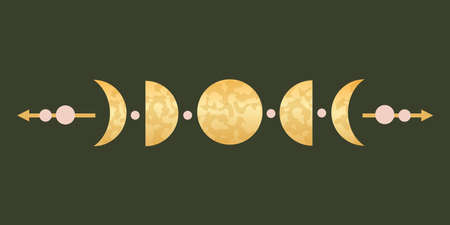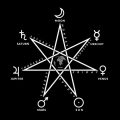Introduction to Lunar Phases
The moon, with its ever-changing face, has captivated the British imagination for generations. At the heart of this fascination lies the science of lunar phases—the observable changes in the moon’s appearance as it orbits Earth. These phases are caused by the interplay between the sun, Earth, and the moon itself: as sunlight illuminates different portions of the moon’s surface, we witness a cycle ranging from new moon to full moon and back again. This celestial dance has not only guided sailors navigating Britain’s historic coastlines but also inspired poets, artists, and spiritual seekers across the country. Understanding why and how these phases occur helps us appreciate both their scientific underpinnings and their enduring cultural significance within British society.
2. The Moon in British History and Folklore
The moon has held a special place in the hearts and minds of people throughout British history, weaving its way through stories, legends, and cultural beliefs that continue to shape our understanding of lunar cycles today. From ancient Celts gathering under the full moon for sacred rituals, to mediaeval tales warning of werewolves and mysterious happenings on moonlit nights, the moon’s phases have long been seen as both a source of wonder and a symbol of change. In pre-Christian Britain, the lunar calendar was often used to mark seasonal festivals such as Beltane and Samhain, reflecting the importance of the moon in agricultural life. Even today, remnants of these beliefs linger in our language—think of phrases like “once in a blue moon” or “lunatic”, which stem from old superstitions about the moon’s power over human behaviour. British folklore is rich with tales explaining the moon’s markings as a man carrying sticks or a hare at rest, each story highlighting how communities made sense of their world through lunar imagery.
Traditional British Moon Legends
| Legend or Belief | Description |
|---|---|
| The Man in the Moon | A popular tale depicts a man banished to the moon for stealing firewood on a Sunday; his figure is imagined in the patterns on the lunar surface. |
| The Hare in the Moon | Many see a hare rather than a man; this imagery links back to Celtic symbolism, where hares were associated with fertility and rebirth. |
| Full Moons and Madness | Old beliefs suggest that sleeping under a full moon or being out at night could drive one mad—a notion that influenced words like “lunacy”. |
| Harvest Moon | The full moon closest to the autumn equinox was vital for farmers, providing extra light to gather crops late into the evening. |
The Moon’s Influence on Modern British Culture
Despite advances in science, many traditional lunar beliefs persist subtly within modern British culture. Gardeners still consult “moon gardening” calendars, planning sowing and harvesting by lunar phases. Artists and poets frequently draw inspiration from moonlit landscapes—a motif that echoes centuries-old connections between nature and creativity. Meanwhile, community events like May Day often incorporate symbols linked to lunar cycles, reminding us how deeply rooted these traditions remain. By exploring these stories and customs, we gain not only insight into our ancestors’ worldviews but also practical wisdom for embracing change and growth in our own lives.

3. Scientific Understanding of Moon Cycles
The lunar cycle, a repeating sequence of phases lasting approximately 29.5 days, is a fascinating natural phenomenon that has shaped both the British landscape and daily life for centuries. The moon’s phases—from new moon to full moon and back—are governed by its position relative to the Earth and Sun. As the moon orbits our planet, varying portions of its surface are illuminated, resulting in the familiar waxing and waning shapes we observe in the night sky. In the UK, the influence of these lunar phases extends far beyond mere observation; they have a tangible impact on natural events and human activities.
The Moon’s Influence on Tides
One of the most significant scientific effects of the lunar cycle in Britain is its role in controlling the tides. The gravitational pull between the Earth and the moon causes the sea levels to rise and fall in a rhythmic pattern. Coastal communities across England, Scotland, Wales, and Northern Ireland are intimately familiar with this process, as high and low tides affect fishing, boating, and even certain local traditions. The spring tides—higher than average—occur during new and full moons when the sun, earth, and moon are aligned. In contrast, neap tides—lower than average—arise during the first and third quarters of the moon.
Lunar Cycles in British Agriculture
Agricultural practices in the UK have also been guided by lunar cycles for generations. Traditional farmers observed that planting certain crops during specific moon phases could influence germination rates and crop yields. For example, it was common wisdom to sow seeds for above-ground crops during a waxing moon (when light increases), while root vegetables were planted during a waning moon (as light decreases). While modern science offers mixed views on these practices, many British gardeners continue to follow lunar planting calendars as part of their routine, blending inherited tradition with practical application.
Everyday Impacts: Nature’s Rhythms in British Life
The lunar cycle remains woven into everyday British life—not just through folklore but through observable effects on nature. Bird migrations, animal breeding patterns, and even certain flowering plants are subtly influenced by the changing light conditions brought about by different moon phases. As you walk along a Cornish coastline or stroll through an Oxfordshire meadow under a bright full moon, consider how these rhythms shape your environment. Recognising these natural patterns can inspire mindfulness and a deeper appreciation for the interconnectedness of science and tradition within British culture.
4. Spiritual Interpretations in Modern Britain
In contemporary Britain, the phases of the moon are not only understood through scientific explanation but also embraced for their spiritual significance. Many people today integrate lunar cycles into their personal and collective practices, seeking meaning and mindfulness in a fast-paced world. The full moon, for instance, is often seen as a time for release and reflection, while the new moon inspires intentions and fresh starts. This holistic perspective draws upon both ancient traditions and modern self-care movements.
Mindfulness and Lunar Cycles
Increasingly, individuals across the UK use the rhythm of the moon as a guide for mindfulness practices. Meditation sessions timed with the full or new moon are popular among those seeking to deepen self-awareness or let go of emotional baggage. Yoga studios may offer “moon flow” classes designed to align physical movements with lunar energy. For many, these practices provide a sense of grounding and connection amid daily pressures.
Modern Holistic Practices Involving Lunar Phases
The resurgence of interest in holistic health has brought about new ways to engage with lunar energy. Modern Britons might use lunar calendars to plan rituals, journaling prompts, or even gardening activities that correspond with specific phases of the moon. Below is an overview of common modern practices associated with each major lunar phase:
| Lunar Phase | Common Practice |
|---|---|
| New Moon | Setting intentions, vision boarding, journaling new goals |
| Waxing Moon | Taking action on plans, starting new projects |
| Full Moon | Meditation, letting go rituals, group gatherings |
| Waning Moon | Reflection, decluttering, releasing old habits |
Cultural Blending and Community Gatherings
In addition to individual practices, there is a growing trend towards community events that celebrate lunar cycles. From full moon drum circles in public parks to online new moon intention-setting workshops, these gatherings foster social connection while promoting collective wellbeing. Such activities often blend British cultural elements—like tea ceremonies or poetry readings—with universal themes of renewal and transformation.
Nurturing Meaning in Everyday Life
The spiritual interpretation of moon phases offers modern Britons tools for navigating lifes uncertainties with greater resilience and purpose. Whether through quiet reflection or shared ritual, connecting with the lunar cycle invites a deeper appreciation for natural rhythms and personal growth—a tradition evolving in step with contemporary British culture.
5. Lunar Rituals and Celebrations in the UK
Across the British Isles, the moon has long been a source of inspiration for rituals, festivals, and community gatherings, weaving together both ancient traditions and modern expressions. Historically, Celtic and pagan communities marked their calendars by the lunar cycle, celebrating significant phases such as the full moon and new moon with communal feasts, bonfires, and storytelling. These celebrations often centred around agricultural cycles, with rituals during the Harvest Moon or the first full moon after the spring equinox signifying times of sowing or reaping.
Traditional Rituals Rooted in Lunar Phases
The Wiccan and pagan revival in contemporary Britain has seen a resurgence of moon-based ceremonies, particularly the Esbat rituals held on each full moon. These gatherings encourage reflection, spiritual cleansing, and setting intentions—practices that blend ancient wisdom with modern mindfulness. In rural parts of Scotland and Wales, echoes of these traditions remain visible during local fairs or informal midnight gatherings where communities come together to share stories under the light of the full moon.
Modern Community Events Inspired by the Moon
In recent years, there has been a growing interest in moon-themed wellness events across UK cities. Yoga studios frequently host full moon yoga sessions or guided meditations designed to harness lunar energy for emotional release and personal growth. Some coastal towns hold “moon swims,” inviting locals to swim in the sea by moonlight—a practice believed to be both invigorating and spiritually cleansing.
Lunar Festivals: Past Meets Present
Beyond spiritual practices, British culture celebrates the moon through artistic events such as outdoor theatre performances scheduled during supermoons or photographic exhibitions capturing lunar landscapes over landmarks like Stonehenge. The annual Autumn Equinox gatherings at ancient sites are often timed with significant lunar phases, blending heritage with community spirit. These events foster connection not only to nature but also to each other, encouraging participants to slow down and find meaning within cyclical change.
In summary, whether through age-old customs or contemporary interpretations, the UK’s relationship with lunar cycles remains vibrant. By participating in these rituals—be it a quiet moment of reflection during a full moon walk or joining a lively festival—Britons continue to honour the moon’s enduring presence in their cultural landscape.
6. Practical Ways to Tune Into the Moon Phases
Embracing the moons rhythm is a time-honoured tradition in the UK, where folklore and rural customs have long woven lunar cycles into daily life. Tuning into the moon phases can foster greater self-awareness, resilience, and intentional living. Here are some practical steps you can take to align with each lunar phase for personal growth and wellbeing.
Observe: Noticing the Moon’s Cycle
Begin by simply looking up—notice the moon’s phase as it waxes and wanes across the British sky. Apps or traditional moon calendars can help track the cycle, but a mindful evening walk or a quiet moment by your window is just as effective. This gentle observation encourages presence and connection with natural rhythms, grounding you in the here and now.
Reflect: Journaling and Self-Inquiry
Keep a lunar journal. At each new or full moon, jot down your thoughts, emotions, intentions, or dreams. Ask yourself questions such as, “What do I want to grow this month?” during the New Moon, or “What am I ready to let go of?” at the Full Moon. Writing by candlelight or in a peaceful nook can add a touch of British cosiness to this reflective ritual.
Act: Intentional Rituals for Each Phase
New Moon – Setting Intentions
The New Moon marks beginnings. In British tradition, this might mean planting seeds (literally or metaphorically) for future projects. Light a candle, sip a calming herbal tea like chamomile, and write down your goals for the coming weeks.
Waxing Moon – Taking Action
As the moon grows, focus on building momentum. In rural Britain, this has often been a time for tending gardens and starting new ventures. Channel this energy into taking small steps towards your intentions, celebrating progress along the way.
Full Moon – Releasing and Celebrating
The Full Moon is traditionally linked with harvests and community gatherings in British culture. Host a simple get-together with friends or family, or spend time outdoors under the moonlight. Reflect on achievements and consciously release what no longer serves you—perhaps by writing it down and burning it safely as part of a letting-go ritual.
Waning Moon – Rest and Renewal
This quieter phase invites rest. Take inspiration from British woodland walks or coastal retreats—allow yourself time to pause, recharge, and prepare for the next cycle. Practice gentle self-care like reading by the fire or enjoying a warm bath.
Cultivating Lunar Mindfulness in Daily Life
Integrating these practices need not be complicated; even small acts of awareness can make a difference. By attuning to the lunar cycle—a subtle but powerful force in British heritage—you cultivate mindfulness and foster ongoing personal growth.


